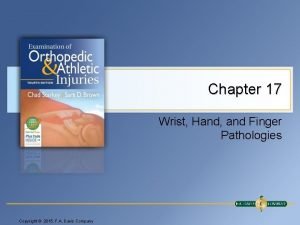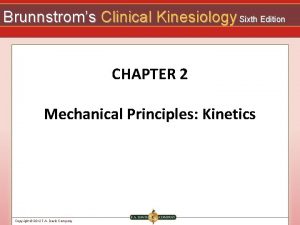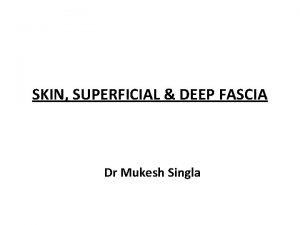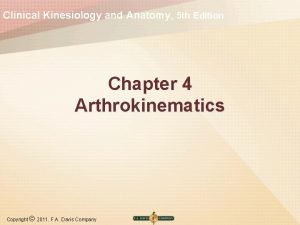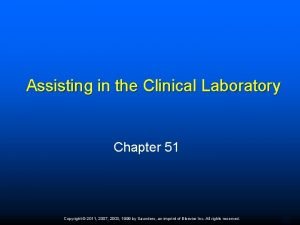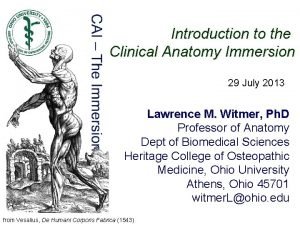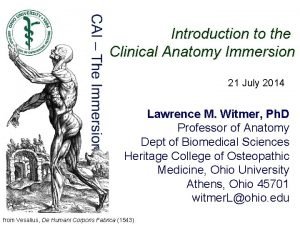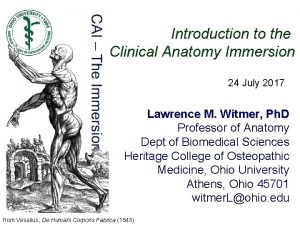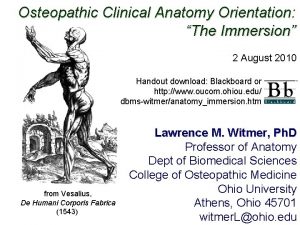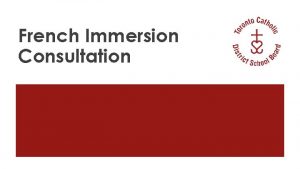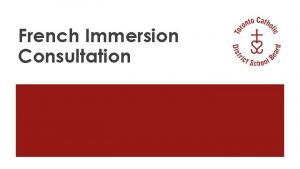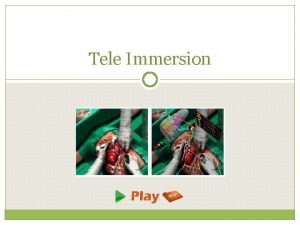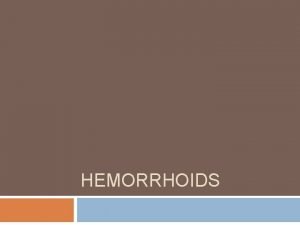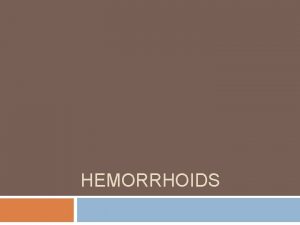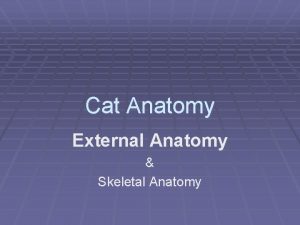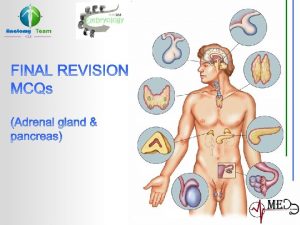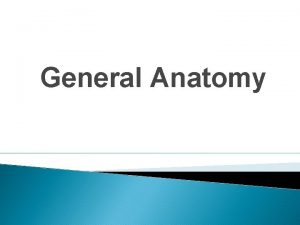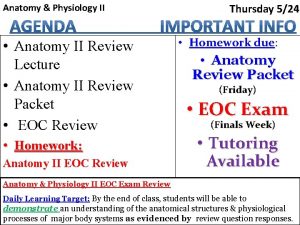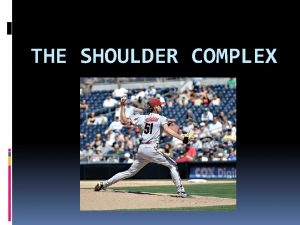Introduction to the Clinical Anatomy Immersion 18 July




















- Slides: 20

Introduction to the Clinical Anatomy Immersion 18 July 2016 Lawrence M. Witmer, Ph. D Professor of Anatomy Dept of Biomedical Sciences Heritage College of Osteopathic Medicine, Ohio University Athens, Ohio 45701 witmer. L@ohio. edu from Vesalius, De Humani Corporis Fabrica (1543)

HCOM – Athens HCOM – Clev eland One College • ~~~ • Three Campuses in l b u D – HCOM

Features of the Immersion • “Immersion”—highly focused, few other activities • Four days per week (Mon-Tues-Thurs-Fri) • Three hours of lab per day, balance of time is largely for reading and other preparation • OMM is the other major player in the Immersion • Frontloads musculoskeletal anatomy (back & limbs) • Has a strong clinical emphasis

Justification for the Immersion • Gross anatomy is the foundation and language of medicine—particularly Osteopathic Manipulative Medicine (OMM) • Provide that foundation prior to beginning the rest of your training • Quickly bring all students up to the same level • Better prepare all our students for OMM training • Provide a clinical focus & orientation at the outset • Starting the process of clinical thinking & problem solving

What Is Clinical Anatomy? Systemic Anatomy arterial system Regional Anatomy Clinical Anatomy head & neck Carpal tunnel syndrome • paresthesia • thenar wasting • hand weakness thorax upper limb abdomen & pelvis lower limb (from M&D COA 6 2010) median nerve

Why Emphasize Clinical Anatomy? • Medical school is for training physicians, not anatomists • Promotes critical thinking and clinical problemsolving using anatomical knowledge • Enhances ability to learn and retain anatomy • Retention is better if learning is done in the context in which it will be ultimately used • “Seeing the forest [clinical application] for the trees [anatomical structures]” • “Reciprocal illumination” • Need anatomy to understand clinical practice

Why Emphasize Clinical Anatomy? A. T. Still’s Four Tenets of Osteopathic Medicine 1. The body is a unit; the person is a unit of mind and body 2. The body is capable of self-regulation, selfhealing, and health maintenance 3. Structure and function are reciprocally interrelated 4. Rational treatment is based on the above three principles Anatomical structure is at the core

Anatomy of the Immersion: staff L. Witmer, Ph. D Professor Instructor of Record Eric Gorscak Grad TA Y. Slyvka, MD Instructor W. R. Porter, Ph. D B. Chadwell, Ph. D Instructor HCOM – Athens Jasmine Croghan Grad TA James Nassif Grad TA Waymon Holloway Grad TA

Anatomy of the Immersion: staff Ashley Bonamer MSIV, DFM Assoc. Leah Bowlin MSIV, OMM Fellow HCOM – Athens Joe Crum OMSII HCOM TA Nateka Faison OMSII HCOM TA Adam Woodyard OMSII HCOM TA Muhammad Umar OMSII HCOM TA Maggy Zorc OMSII HCOM TA

Anatomy of the Immersion: staff A. Biknevicius, Ph. D Associate Professor R. Code, Ph. D Associate Professor Nakul Bhardwaj MSIV OMM/DFM Associate HCOM – Dublin Sean Pugh OMSII HCOM TA Maggie Watt OMSII HCOM TA Kelly Irwin MSIV OMM/DFM Associate

Anatomy of the Immersion: staff J. O’Reilly, Ph. D Instructor Wei-Ming Duan, MD, Ph. D Instructor Kevin De. Groot Emily Lanzola OMM/DFM Associate OMM/ DFM Associate HCOM – Cleveland Michael Gercevich OMSII HCOM TA Darcy Hull OMSII HCOM TA Dajan Juric OMSII HCOM TA

Anatomy of the Immersion: The Lab • 4 or 5 students/table A B A B A B A • Athens: Sections A & B, alternate AM/PM slot weekly • Teams do their own dissections. Division of labor: cutters, readers, … • Dissect BOTH sides of the donor • Come to lab at off times to finish up • Attendance in lab is mandatory

Anatomy of the Immersion: The Lab Mandatory Attendance Why? • Material is central to your training • Responsibility to your dissecting team • Honoring the gift of a donated body Stay for the whole lab • Work on dissection • If dissection is completed, work with other resources (e. g. , other donors, bones, imaging, etc. )

Anatomy of the Immersion: Imaging Dr. Jeffery S. Benseler, DO Medical Imaging Basics in Mediasite • online video modules • online self-study Power. Points • Face-to-face session Aug 9 th Medical Imaging Basics • four asynchronous learning modules in Mediasite • linked on Blackboard under “Imaging Resources” • provide foundations of different imaging modalities • won’t be assessed on the details but view well before Aug 9 th session Online Self-study Power. Points • linked on Blackboard under “Imaging Resources” • required content on which you will be assessed according to these dates • Lumbar Spine Imaging: Exam 1 – Tuesday, July 26 th • Cervical Spine Imaging: Exam 1 – Tuesday, July 26 th • Upper Extremity Imaging: Exam 2 – Monday, August 8 th • Lower Extremity Imaging: Exam 3 – Friday, August 19 th

Anatomy of the Immersion: Imaging Stations • Plain, CT, MRI • Importance of sectional anatomy for imaging • Very detailed but provide key correlations • Use Dr. Benseler’s PPTs as guide for exam

Anatomy of the Immersion: Online http: //www. ohio. edu/people/witmerl/3 D_human. htm 3 D PDFs movies

Anatomy of the Immersion: Clinical Themes & Question of the Day A A A A Faculty A A A Clinical Themes • Posted at the beginning of lab • Provide clinical correlations • For your reference; instructors may or may not discuss • Available online prior to lab A A Fellow/Associate Question of the Day (QOD) • Short clinical vignette • Table team explores the QOD • Faculty & Fellow/Associates will discuss QOD with trios or pairs of tables

Anatomy of the Immersion: Books • Relevant pages to read are on the schedule. • Moore’s Clinical “Blue Boxes” are key (but you won’t understand them without reading what’s between!) • Dissector & Atlas must be at each table! • Read dissector prior to coming to lab • i. Pad and Kindle version of books are fine • Anatomy. tv by Primal Pictures (click image below)

Anatomy of the Immersion: Assessment 1. Four self-assessment quizzes online on Blackboard 2. Three sets of written (Exam. Soft e-tests) and practical exams 1. Tuesday, July 26 th – Back 2. Monday, August 8 th – Upper Extremity 3. Friday, August 19 th – Lower Extremity 3. Year-2 med student assistants will be setting up mock practicals

Donors & Body Donation • Role of the donor: 3 D anatomy, variation, “diagnosis” of pathology, etc. • Significance of the donor • A profound experience • Directly see & handle structures you’ll later have to imagine • Opportunity and privilege to work on an actual human • Potentially uncomfortable feelings • Death: Illness, end-of-life, dying, corporeal remains • A very different kind of intimacy • Overcoming societal taboos • Sadness: clear evidence of their humanity • Body donation • Conscious, often family decision to donate • The ultimate gift • Honoring that gift • Respect, professionalism • USE the gift: prepare for lab, don’t miss lab, study & learn from all the donors • Great book! — Body of Work, by C. Montross, MD
 What is conflict in work immersion
What is conflict in work immersion Watson test wrist
Watson test wrist Dorsal nucleus of vagus
Dorsal nucleus of vagus Clinical kinesiology and anatomy 6th edition
Clinical kinesiology and anatomy 6th edition Roof nasal cavity
Roof nasal cavity Langer lines
Langer lines Clinical kinesiology and anatomy 6th edition
Clinical kinesiology and anatomy 6th edition Introduction to clinical chemistry
Introduction to clinical chemistry Chapter 45 introduction to the clinical laboratory
Chapter 45 introduction to the clinical laboratory Archie smith boy wonder
Archie smith boy wonder Oscar and alphonse harris burdick
Oscar and alphonse harris burdick July 1-4 1863
July 1-4 1863 Gcc july 2020
Gcc july 2020 Antwrp
Antwrp 2001 july 15
2001 july 15 2003 july 17
2003 july 17 July 30 2009 nasa
July 30 2009 nasa Sources nso frenchhowell neill mit technology...
Sources nso frenchhowell neill mit technology... What is the significance of july 4 1776 brainpop
What is the significance of july 4 1776 brainpop Poppies in july aoifes notes
Poppies in july aoifes notes Hurrah for the fourth of july cartoon
Hurrah for the fourth of july cartoon

